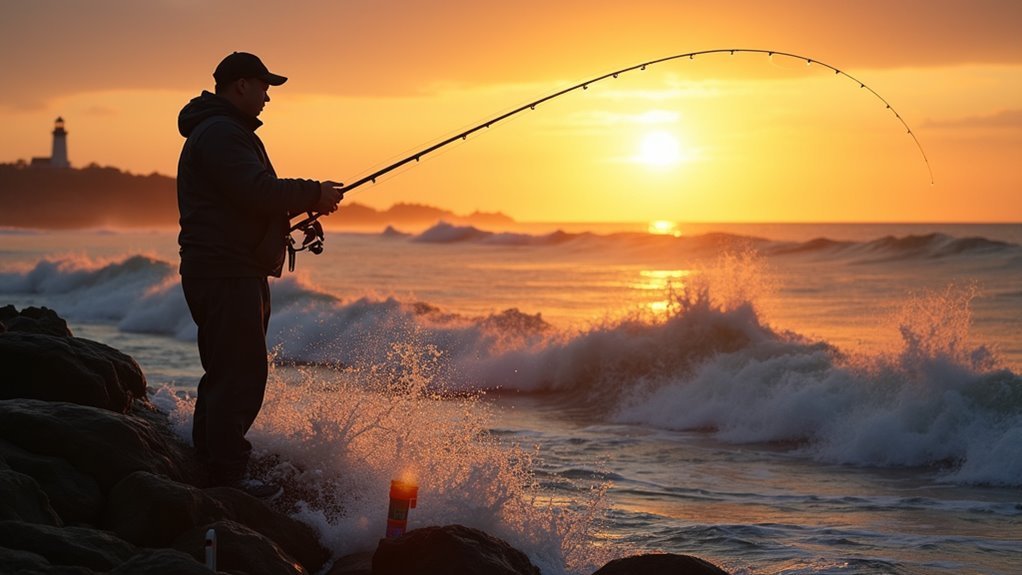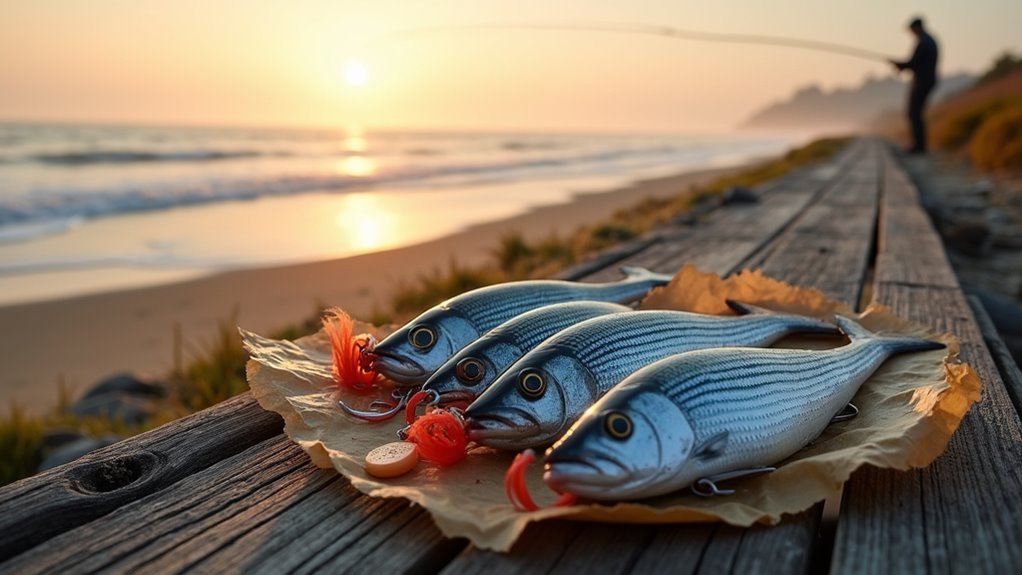To master striper surf fishing, you’ll need to understand their seasonal migration patterns and temperature preferences (58-68°F). Use a 10-11 foot medium-heavy surf rod with 20-50 pound braided line, and focus on finding troughs where fish ambush prey. Adjust your presentation seasonally—slower retrieves in spring, more aggressive in fall. Look for diving birds and baitfish activity, and fish prime tidal periods. Persistence through challenging conditions often separates casual anglers from those who consistently land trophy bass.
Understanding Striped Bass Migration Timing and Patterns

When it comes to mastering striper surf fishing, understanding the seasonal migration patterns is absolutely critical to your success.
Striped bass follow predictable routes along the East Coast, moving south from Maine to Maryland each autumn and reversing course in spring around mid-April.
Water temperature is perhaps the biggest influence on their movement. They typically prefer waters between 58-68°F.
Following the thermometer is the surest path to finding stripers—they’re creatures of comfort in that sweet 58-68°F range.
I’ve found that the fall run happens quicker—they’re swimming with urgency as temperatures drop—while spring migration stretches out more leisurely.
Tracking baitfish is essential too. Look for peanut bunker, sand eels, or mullet.
Their presence often signals stripers aren’t far behind.
Essential Surf Fishing Gear and Tackle Selection
As you prepare to take on the challenges of surf fishing for stripers, selecting the right gear can make or break your experience on the beach. A surf rod of at least 10-11 feet is essential for casting distance, paired with a medium-heavy action for handling larger lures.
Don’t skimp on your tackle selection. I think a well-stocked surf bag should include diamond jigs up to 3 ounces, bucktails, and perhaps some Kastmasters in various colors.
Braided line (20-50 pound test) with fluorocarbon leaders provides the perfect balance of strength and stealth.
Remember to check your leaders regularly for nicks—this small habit prevents heartbreaking break-offs when that trophy striper hits.
Reading Beach Structure and Identifying Productive Troughs
Beach structure constantly reveals secrets to the observant angler, yet many surf fishermen overlook these essential details.
When selecting your spot, look for steep drop-offs where stripers ambush bait – flat, gradually sloping beaches rarely produce consistent action.
The key is identifying troughs, those deeper channels running parallel to shore. You’ll notice them by counting wave sets – multiple breaking waves often indicate a sandbar with a trough behind it.
I think these are best spotted at low tide, usually 100-200 yards out.
Time your fishing around the tides.
Perhaps the most productive period is 1-3 hours on either side of high tide, when bait gets trapped in these structures.
Strategic Bait and Lure Presentation for Fall Stripers

During the fall migration, successful striper fishing hinges on your lure and bait presentation more than almost any other factor.
When those big bass are chasing baitfish along the coast, they’re looking for wounded, struggling prey that stands out from the school.
I think matching your retrieve to water conditions is essential.
In rougher surf, perhaps work your lures with more erratic, aggressive movements – stripers often feed more aggressively then.
For bait fishing, fresh bunker chunks seem to outperform frozen ones nearly every time.
Don’t overthink it though.
Sometimes a simple, slow retrieve with brief pauses just feels more natural to them.
Adapting Techniques for Spring vs. Fall Conditions
While spring and fall both offer prime opportunities for striper fishing, they demand distinctly different approaches to be successful.
I think it’s that gradual warming trend in spring versus the rapid cooling in fall that really changes how stripers behave.
When adapting your techniques between seasons, remember:
- Spring fish move slower – use lighter lures and more patient retrieves
- Fall stripers feed aggressively – larger lures and faster presentations work better
- Dawn/dusk advantages shift – fall fish often hit midday during cold fronts
- Bait selection matters – match peanut bunker in fall, sand eels in spring
Perhaps the biggest difference is simply urgency – spring fish are exploring, while fall fish are racing south.
Maximizing Success With Observation and Persistence
Although technology has transformed modern fishing with depth finders and GPS, successful striper surf fishing still relies heavily on your powers of observation and sheer persistence. Scanning the horizon with binoculars can reveal distant blitzing fish or diving birds that signal feeding activity.
I think what separates casual anglers from the consistently successful ones is their willingness to brave uncomfortable conditions. Those late-season blitzes in December? They often go unnoticed because most fishermen have packed it in for the year.
Frequently Asked Questions
How Do Moon Phases Affect Striper Feeding Behavior?
You’ll notice stripers feed more aggressively during new and full moons when tidal movements are stronger, creating better current flow and increased baitfish activity near shorelines.
When Should I Switch From Artificial Lures to Live Bait?
When the fish are playing hard to get, switch to live bait. You’ll want to change tactics when artificial lures aren’t producing strikes or when stripers are feeding more cautiously during midday or clear water conditions.
How Long Do I Stay at One Spot Before Moving?
Stay at a spot for 30-45 minutes if you’ve seen signs of fish. If it’s completely dead with no bites, birds, or bait activity, move after 15-20 minutes.
Can I Catch Stripers During Heavy Rain or Thunderstorms?
Thunder rolls as rain pelts the beach – you can catch stripers during heavy rain, but avoid fishing in thunderstorms for safety. Rain often increases feeding activity, especially during dawn or dusk.
How Do I Avoid Getting Skunked on Crowded Beaches?
To avoid getting skunked on crowded beaches, arrive early, fish during low-light periods, target structure others miss, move frequently between spots, and try different lures than everyone else is using.